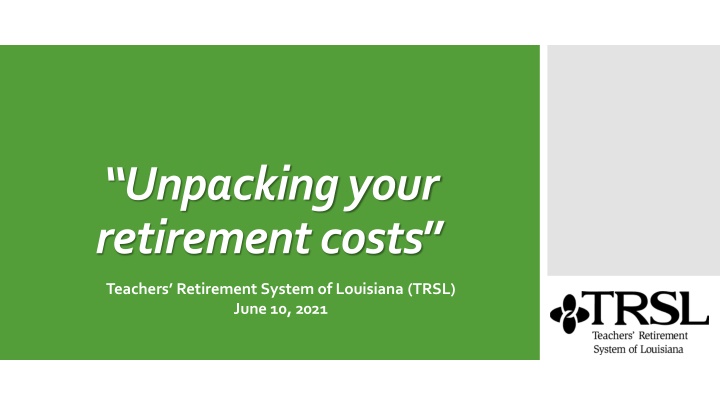
Unpacking Retirement Costs: TRSL Guidelines for Future Benefits
Learn how Teachers Retirement System of Louisiana (TRSL) determines retirement costs through present value calculations, funding requirements, and the impact of discount rates on pension liabilities. Explore the factors influencing TRSL's cost determinations and the importance of financial planning for future retirement benefits.
Download Presentation

Please find below an Image/Link to download the presentation.
The content on the website is provided AS IS for your information and personal use only. It may not be sold, licensed, or shared on other websites without obtaining consent from the author. If you encounter any issues during the download, it is possible that the publisher has removed the file from their server.
You are allowed to download the files provided on this website for personal or commercial use, subject to the condition that they are used lawfully. All files are the property of their respective owners.
The content on the website is provided AS IS for your information and personal use only. It may not be sold, licensed, or shared on other websites without obtaining consent from the author.
E N D
Presentation Transcript
Unpacking your retirement costs Teachers Retirement System of Louisiana (TRSL) June 10, 2021
Amount set in statute Employee contributions Regular Plan (8% of salary) Plan B (5% of salary) How are retirements funded? Employer contributions Amount determined annually by TRSL actuary Percentage of payroll for members Investment income Employee and employer contributions pooled and invested by TRSL
TRSL is not a pay-as-you-go plan like Social Security. Retirement benefits are actuarially funded throughout the member s working career. How are costs determined? TRSL must determine the present value of future benefits, which is based on: Benefits already accrued from past years; Benefits accruing from the current year (normal cost); and Benefits projected for future years
Determining Present Value of Future Benefits & Funding Requirements TRSL data: How are costs determined? Plan provisions: laws and rules governing the plan Census info: demographics (age/gender), service credit, salary, etc. Plan assets: financial data Assumptions adopted by the TRSL Board: Demographic: rates for retirement, mortality, disability, termination, etc. Economic: discount rate, inflation rate, salary growth, etc.
Used to determine present value of future pension benefits (present value of money is assumed to grow over time to pay for benefits) and funding requirements Is generally the expected long-term rate of return on system assets Represents only the portion of expected returns used to fund regular plan benefits More about the discount rate Impact of discount rate on present value of future pension benefits and funding requirements: HIGH Results in a lower present value of future pension benefits (pension liability) requiring lower funding requirements DISCOUNT RATE LOW Results in a higher present value of future pension benefits (pension liability) requiring higher funding requirements DISCOUNT RATE
Sensitivity of the Net Pension Liability to Changes in the Discount Rate Current Discount Rate (7.45%) 1% Decrease (6.45%) 1% Increase (8.45%) More about the discount rate Employers Net Pension Liability $14.5B $11.1B $8.3B Source: FY 2020 TRSL Actuarial Valuation
Administrative Expenses What s included in the employer contribution rate? Shared UAL Payment Normal Cost Total Employer Rate
Normal Cost What s included in the employer contribution rate? For FY 2021-22 (K-12): 3.33% Actual cost of defined benefit (DB) Lower than Social Security (6.2%) Modest cost for reliable, lifetime benefit
Admin Expenses What s included in the employer contribution rate? For FY 2021-22: 0.38% Since FY 2017-18, non-investment related administrative expenses have been funded directly through employer contributions rather than amortized over 30 years.
Shared UAL Payment What s included in the employer contribution rate? For FY 2021-22: 21.47% State chose to pay UAL through employer contributions UAL has two notable payoff dates: (1) 2029 for debt existing before June 30, 1988; and (2) 2040 for remainder of UAL that existed as of 2009. All other debt schedules amortized over 30 years until system is 70% funded; then moved to 20-year amortizations
Constitutional amendment required TRSL to be actuarially funded Unpacking the UAL Payment plan restructured to prioritize debt payment TRSL created Benefits paid and service credit granted without necessary contributions made Legislators later created back-loaded IUAL payment schedule with 2029 payoff date First $200M of excess investment earnings go toward UAL payment. $200M amount grows as actuarial value of assets grows. UAL history & pension reform 1936 1987 2009 2014
More level UAL payments; no balloon payments Unpacking the UAL UAL balance decreasing; expect to meet payoff deadlines Principal and interest have been paid on UAL since FY 2013 Given reforms enacted since 2009 More than $1.06 billion in excess earnings directly applied to reduce UAL balance
Unpacking the UAL Balance & Payments
PROJECTED EMPLOYER COSTS NORMAL COST ADMIN EXPENSE UAL TOTAL RATE Unpacking the UAL FY PAYMENT 2.40% 0.40% 17.90% 20.80% 2024 2.00% 0.40% 16.20% 18.60% 2028 2032 1.70% 0.40% 11.70% 13.80% Projected future employer contributions 2036 1.50% 0.40% 10.50% 12.40% 2048 1.30% 0.40% -0.30% 1.40% NOTE: Based on certain assumptions, including that all actuarial assumptions will be realized and 7.50% market value return in all years.
UAL paid off on time Unpacking the UAL Employer contributions expected to decrease Good News! System funded status expected to increase
Teachers Retirement System of Louisiana (TRSL) Questions?
